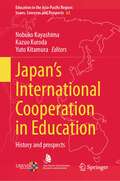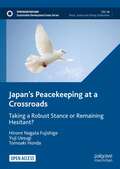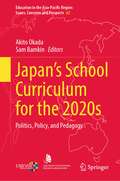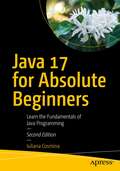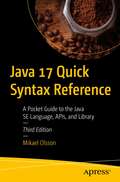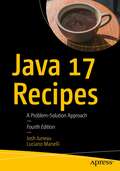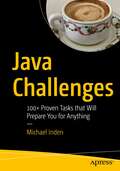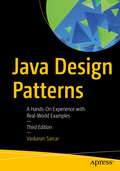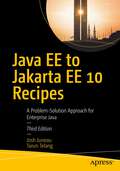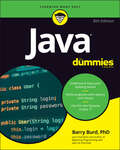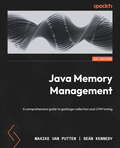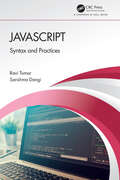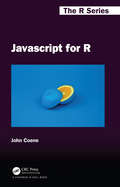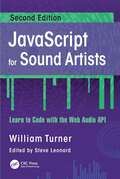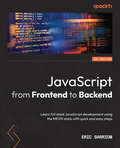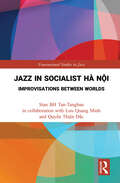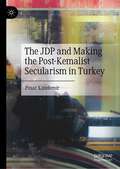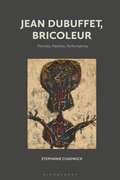- Table View
- List View
Japan’s International Cooperation in Education: History and Prospects (Education in the Asia-Pacific Region: Issues, Concerns and Prospects #63)
by Nobuko Kayashima Kazuo Kuroda Yuto KitamuraThis book records the history of Japan’s international cooperation in education from the 1950s to 2020. It provides a crucial overview of the nearly 70 years since Japan began engaging in international cooperation in education in order to record and document these efforts that range from basic to higher education to technical and vocational education and training, and the large numbers of people involved in their respective areas of activity and specialization. The book provides useful indicators for exploring new forms of education cooperation in this age of global governance and beyond. The authors include not only researchers but also field practitioners, such as personnel from the Japan International Cooperation Agency and NGOs.Chapters 1, 3, 5, 9, 12 and 15 are available open access under a Creative Commons Attribution-NonCommercial-NoDerivatives 4.0 International License via link.springer.com.
Japan’s Peacekeeping at a Crossroads: Taking a Robust Stance or Remaining Hesitant? (Sustainable Development Goals Series)
by Yuji Uesugi Hiromi Nagata Fujishige Tomoaki HondaThis open access book examines why Japan discontinued its quarter-century history of troop contribution to UN Peacekeeping Operations (1992–2017). Japan had deployed its troops as UN peacekeepers since 1992, albeit under a constitutional limit on weapons use. Japan’s peacekeepers began to focus on engineering work as its strength, while also trying to relax the constraints on weapons use, although to a minimal extent. In 2017, however, Japan suddenly withdrew its engineering corps from South Sudan, and has contributed no troops since then. Why? The book argues that Japan could not match the increasing “robustness” of recent peacekeeping operations and has begun to seek a new direction, such as capacity-building support.
Japan's Prosecution Review Commission: On the Democratic Oversight of Decisions Not To Charge (Palgrave Advances in Criminology and Criminal Justice in Asia)
by David T. JohnsonThis book explains Japan’s unique Prosecution Review Commission (PRC) which is composed of eleven lay people selected randomly from voter registration lists. Each of the country’s 165 PRCs reviews non-charge decisions made by professional prosecutors and determines which cases should be reinvestigated or charged. PRCs also provide prosecutors with general proposals and recommendations for improving their policies and practices. The book analyzes the history and operations of the PRC and uses statistics and case studies to examine its various impacts, from legitimation and shadow effects to kickbacks and mandatory prosecution.More broadly, this book explores a problem that is common in many criminal justice systems: how to hold prosecutors accountable for their non-charge decisions. It discusses the potential these panels have for improving the quality of criminal justice in Japan and other countries, and it will appeal to scholars and students studying prosecution and democracy, criminal justice, criminology, lay participation, justice reform, and Japanese studies.
Japan’s School Curriculum for the 2020s: Politics, Policy, and Pedagogy (Education in the Asia-Pacific Region: Issues, Concerns and Prospects #67)
by Akito Okada Sam BamkinJapan’s school curriculum, revised for the 2020s, introduces new subjects and, perhaps more importantly, a new vision for teaching referred to as 'active learning'. This book examines the social and political realities that provided space for this unprecedented curriculum reform; the policymaking process through which it was refined; its envisaged pedagogy, and the intended and unintended outcomes of the new requirements, both on the ground in each school subject and across the education system. Finally, the book steps back to consider the possible future of ‘active learning’ and direction of the course of study in this decade and the next. This book will be of interest to those researching contemporary Japanese education, education policy, curriculum studies and equality of educational opportunity.
Java 17 for Absolute Beginners: Learn the Fundamentals of Java Programming
by Iuliana CosminaWrite your first code in Java 17 using simple, step-by-step examples that model real-word objects and events, making learning easy. With Java 17 for Absolute Beginners you’ll be able to pick up the concepts without fuss. It teaches Java development in language anyone can understand, giving you the best possible start. You’ll see clear code descriptions and layout so that you can get your code running as soon as possible. Author Iuliana Cosmina focuses on practical knowledge and getting you up to speed quickly—all the bits and pieces a novice needs to get started programming in Java. First, you’ll discover what type of language Java is, what it is good for, and how it is executed. With the theory out of the way, you’ll install Java, choose an editor such as IntelliJ IDEA, and write your first simple Java program. Along the way you’ll compile and execute this program so it can run on any platform that supports Java. As part of this tutorial you’ll see how to write high-quality code by following conventions and respecting well-known programming principles, making your projects more professional and efficient. Java 17 for Absolute Beginners gives you all you need to start your Java programming journey. No experience necessary. After reading this book, you'll come away with the basics to get started writing programs in Java. What You Will Learn Get started with Java 17 from scratch Use data types, operators, and the stream API Install and use the IntelliJ IDEA and the Gradle build tool Exchange data using the new JSON APIs Play with images using multi-resolution APIs Implement the publish-subscribe architecture Who This Book Is For Those who are new to programming and who want to start with Java.
Java 17 Quick Syntax Reference: A Pocket Guide to the Java SE Language, APIs, and Library
by Mikael OlssonQuickly gain the insight necessary to address a multitude of Java coding challenges using this succinct reference guide, Java 17 Quick Syntax Reference, Third Edition. Short, focused code examples will help you learn and master various existing and new Java source code elements. This edition includes the following additions to Java SE and OpenJDK, through Java 17: Pattern matching for switch and instanceof, Sealed classes and interfaces, Switch expressions, Text block multiline strings, Java module system, Private methods in interfaces, and Type inference for local variables. You won’t find any technical jargon, bloated samples, drawn out history lessons or witty stories in this book. What you will find is a language reference that is concise, to the point and highly accessible. The book is packed with useful information and is a must-have for any Java programmer.What You Will LearnRun a Java file with a single commandLearn what a switch expression is and how to use itUse pattern matchingCode with Java modulesCreate text blocks to handle multiline stringsLearn what sealed classes are and how to use these and moreWho This Book Is ForThose with prior experience with Java who want a quick and handy reference.
Java 17 Recipes: A Problem-Solution Approach
by Josh Juneau Luciano ManelliQuickly find solutions to dozens of common programming problems encountered while building Java applications, with recipes presented in the popular problem-solution format. Look up the programming problem that you want to resolve. Read the solution. Apply the solution directly in your own code. Problem solved!Java 17 Recipes is updated to reflect changes in specification and implementation since the Java 9 edition of this book. Java 17 is the next long-term support release (LTS) of the core Java Standard Edition (SE) version 17 which also includes some of the features from previous short term support (STS) releases of Java 16 and previous versions. This new edition covers of some of the newest features, APIs, and more such as pattern matching for switch, Restore Always-Strict-Floating-Point-Semantics, enhanced pseudo-random number generators, the vector API, sealed classes, and enhancements in the use of String. Source code for all recipes is available in a dedicated GitHub repository. This must-have reference belongs in your library.What You Will Learn Look up solutions to everyday problems involving Java SE 17 LTS and other recent releasesDevelop Java SE applications using the latest in Java SE technologyIncorporate Java major features introduced in versions 17, 16, and 15 into your code Who This Book Is For Programmers and developers with some prior Java experience.
Java Challenges: 100+ Proven Tasks that Will Prepare You for Anything
by Michael IndenExpand your knowledge of Java with this entertaining learning guide, which features 100+ exercises and programming challenges. Java Challenges will prepare you for your next exam or job interview, and covers many practical topics, such as strings, arrays, data structures, recursion, and date and time. The APIs and other material included in this book are Java 17 compatible. Each topic is addressed in its own separate chapter, starting with an introduction to the basics and followed by multiple exercises of varying degrees of difficulty, helping you to improve your programming skills effectively. Detailed sample solutions, including the algorithms used for all tasks, are included to maximize your understanding of each area. Author Michael Inden also describes alternative solutions and analyzes possible pitfalls and typical errors. Three appendices round out the book: one covering JShell, which is often helpful for trying out the code snippets and examples in the book, followed by an introduction to JUnit 5 for unit testing and verifying solutions, while the final appendix explains O-notation for estimating performance. After reading this book, you'll be prepared to take the next step in your career or tackle your next personal project. All source code is freely available for download via the Apress website. What You Will Learn Improve your Java knowledge by solving enjoyable but challenging programming puzzles Solve mathematical problems, recursions, strings, arrays and moreManage data processing and data structures like lists, sets, mapsHandle advanced recursion as well as binary trees, sorting and searching Gamify key fundamentals for fun and easier reinforcement Who This Book Is For Professional software developers, makers, as well as computer science teachers and students. At least some prior experience with Java programming is recommended.
Java Design Patterns: A Hands-On Experience with Real-World Examples
by Vaskaran SarcarUse the step-by-step approach of this book to learn and implement design patterns in real-world applications. It focuses on classical design patterns with Java 17 and Eclipse (2021-09). In addition to Gang of Four (GoF) design patterns, the book covers popular and alternative design patterns and includes criticisms of design patterns in a chapter on anti-patterns. The book is divided into four parts. Part one covers the SOLID design principles and the Simple Factory pattern. Part two covers the 23 (GoF) design patterns, including the creational patterns, structural patterns, and behavioral patterns. Part three covers alternative design patterns, including the Null Object pattern, and the model-view-controller (MVC) pattern. Part four covers criticisms of design patterns with a quick overview of anti-patterns. It also includes a chapter on FAQs on design patterns.The book also includes a chapter on FAQs on design patterns. Each pattern is explained with real-world examples and the pros and cons of each of the design patterns are discussed. The book concludes with FAQs that can help you prepare for a job interview.What You Will LearnKnow the SOLID design principles in depthImplement the 23 design patterns from the GoFApply the Null Object pattern, Simple Factory pattern, and the MVC patternKnow the criticism of design patterns Understand the anti-patternsVerify your understanding through Q&A sessionsSelect an alternative to these patterns by comparing their pros and consWho This Book Is ForSoftware developers, architects, and programmers
Java EE to Jakarta EE 10 Recipes: A Problem-Solution Approach for Enterprise Java
by Josh Juneau Tarun TelangTake a problem-solution approach for programming enterprise Java or Java EE applications and microservices for cloud-based solutions, enterprise database applications, and even small business web applications. Java EE to Jakarta EE 10 Recipes provides effective, practical, and proven code snippets that you can immediately use to accomplish just about any task that you may encounter. You can feel confident using the reliable solutions that are demonstrated in this book in your personal or corporate environment. Java EE was made open source under the Eclipse Foundation, and Jakarta EE is the new name for what used to be termed the Java Platform, Enterprise Edition. This book helps you rejuvenate your Java expertise and put the platform’s latest capabilities to use for quickly developing robust applications. If you are new to Jakarta EE, this book will help you learn the features of the platform and benefit from one of the most widely used and powerful technologies available for cloud-native enterprise application development today. Examples in this book highlight Jakarta EE’s capabilities, helping you to build streamlined and reliable applications using the latest in Java technologies. The book takes a problem-solution approach in which each section introduces a common programming problem, showing you how to solve that problem in the best possible way using the latest features in Jakarta EE. Solutions in the form of working code examples are presented that you can download and use immediately in your own projects. Clear descriptions are provided to help you understand and learn to build further on the solutions provided. This is the ideal book for the code-focused programmer interested in keeping up with the future of enterprise development on the Java Platform. What You Will Learn Develop enterprise java applications using the latest open-source Jakarta EE platformCreate great-looking user interfaces using Jakarta Servlets, Jakarta Server Pages, Jakarta Server Faces and the Eclipse Krazo framework (an implementation of Jakarta MVC)Build database applications using Jakarta NoSQL, Jakarta Persistence, and Jakarta Enterprise Beans.Develop enterprise grade applications using Context & Dependency Injection, and Jakarta RESTFul web servicesAutomate testing through cohesive test suites built on Arquillian for Jakarta EE applicationsBuild loosely coupled distributed applications using Jakarta MessagingDeploy microservices applications in cloud environments using DockerSecure applications utilizing the Jakarta EE Security API Who This Book Is For Java developers interested in quickly finding effective and proven solutions without reading through a lengthy manual and scrubbing for techniques.
Java For Dummies
by Barry BurdLearn to write practical, reusable code with the straightforward tutorials and tips in the newest edition of this For Dummies bestseller Do you speak Java? No, we’re not talking about your morning cup ‘o joe. We mean the world’s most popular programming language that runs on almost any computer! If you’re looking to get started—or up your game—with Java, then Java For Dummies is the guide you need. In this book, you’ll: Take control of your program flow Program with classes, objects, and methods Use Java's functional programming features Explore Java 17, the latest long-term support release This up-to-date handbook covers the latest developments in Java, including the new ‘switch’ statement syntax. So, if you’re ready to dive into one of the most practical (and coolest!) programming languages around, it’s time you picked up Java For Dummies.
Java For Dummies
by Barry BurdLearn to write practical, reusable code with the straightforward tutorials and tips in the newest edition of this For Dummies bestseller Do you speak Java? No, we’re not talking about your morning cup ‘o joe. We mean the world’s most popular programming language that runs on almost any computer! If you’re looking to get started—or up your game—with Java, then Java For Dummies is the guide you need. In this book, you’ll: Take control of your program flow Program with classes, objects, and methods Use Java's functional programming features Explore Java 17, the latest long-term support release This up-to-date handbook covers the latest developments in Java, including the new ‘switch’ statement syntax. So, if you’re ready to dive into one of the most practical (and coolest!) programming languages around, it’s time you picked up Java For Dummies.
Java Memory Management: A Comprehensive Guide To Garbage Collection And Jvm Tuning
by Sean Kennedy Maaike Van PuttenA comprehensive guide to garbage collection and JVM tuning
JavaScript: Syntax and Practices
by Ravi Tomar Sarishma DangiJavaScript is an easy-to-use, flexible, dynamic, prototype-based programming language predominantly used over the web. Although the initial focus of the language was to assist in the generation of dynamic web content, it soon found its way into numerous other applications. This book aims to cover the fundamentals of the language by providing a strong start for people who wish to start their journey to the JavaScript programming language. It provides the mandatory theoretical background, which is much needed for implementation of the exhaustive hands-on exercises and includes over 4000 lines of code for grasping a maximum understanding of the material. FEATURES A strong theoretical background and understanding of the fundamentals of the JavaScript language Hands-on and demo exercises at the end of every chapter Exercises, theory-based questions, MCQs and true/false questions for helping readers to evaluate their understanding from time to time A dedicated chapter providing extended case studies for using the language This book is targeted at undergraduate as well as postgraduate students who want to learn about front-end programming or who wish to learn a lightweight, easy-to-use programming language for working on their projects. For programmers having experience in other languages, it will serve as a quick summary to get a hold of a new language.
JavaScript: Syntax and Practices
by Ravi Tomar Sarishma DangiJavaScript is an easy-to-use, flexible, dynamic, prototype-based programming language predominantly used over the web. Although the initial focus of the language was to assist in the generation of dynamic web content, it soon found its way into numerous other applications. This book aims to cover the fundamentals of the language by providing a strong start for people who wish to start their journey to the JavaScript programming language. It provides the mandatory theoretical background, which is much needed for implementation of the exhaustive hands-on exercises and includes over 4000 lines of code for grasping a maximum understanding of the material. FEATURES A strong theoretical background and understanding of the fundamentals of the JavaScript language Hands-on and demo exercises at the end of every chapter Exercises, theory-based questions, MCQs and true/false questions for helping readers to evaluate their understanding from time to time A dedicated chapter providing extended case studies for using the language This book is targeted at undergraduate as well as postgraduate students who want to learn about front-end programming or who wish to learn a lightweight, easy-to-use programming language for working on their projects. For programmers having experience in other languages, it will serve as a quick summary to get a hold of a new language.
Javascript for R (Chapman & Hall/CRC The R Series)
by John CoeneLittle known to many, R works just as well with JavaScript—this book delves into the various ways both languages can work together. The ultimate aim of this work is to put the reader at ease with inviting JavaScript in their data science workflow. In that respect the book is not teaching one JavaScript but rather we show how little JavaScript can greatly support and enhance R code. Therefore, the focus is on integrating external JavaScript libraries and no prior knowledge of JavaScript is required. Key Features: ● Easy to pick up. ● An entry way to learning JavaScript for R. ● Covers topics not covered anywhere else. ● Easy to follow along.
Javascript for R (Chapman & Hall/CRC The R Series)
by John CoeneLittle known to many, R works just as well with JavaScript—this book delves into the various ways both languages can work together. The ultimate aim of this work is to put the reader at ease with inviting JavaScript in their data science workflow. In that respect the book is not teaching one JavaScript but rather we show how little JavaScript can greatly support and enhance R code. Therefore, the focus is on integrating external JavaScript libraries and no prior knowledge of JavaScript is required. Key Features: ● Easy to pick up. ● An entry way to learning JavaScript for R. ● Covers topics not covered anywhere else. ● Easy to follow along.
JavaScript for Sound Artists: Learn to Code with the Web Audio API
by William Turner Steve LeonardLearn how to program JavaScript while creating interactive audio applications with JavaScript for Sound Artists: Learn to Code With the Web Audio API! William Turner and Steve Leonard showcase the basics of JavaScript language programing so that readers can learn how to build browser based audio applications, such as music synthesizers and drum machines. The companion website offers further opportunity for growth. Web Audio API instruction includes oscillators, audio file loading and playback, basic audio manipulation, panning and time. This book encompasses all of the basic features of JavaScript with aspects of the Web Audio API to heighten the capability of any browser. Key Features Uses the readers existing knowledge of audio technology to facilitate learning how to program using JavaScript. The teaching will be done through a series of annotated examples and explanations. Downloadable code examples and links to additional reference material included on the books companion website. This book makes learning programming more approachable to nonprofessional programmers The context of teaching JavaScript for the creative audio community in this manner does not exist anywhere else in the market and uses example-based teaching
JavaScript for Sound Artists: Learn to Code with the Web Audio API
by William Turner Steve LeonardLearn how to program JavaScript while creating interactive audio applications with JavaScript for Sound Artists: Learn to Code With the Web Audio API! William Turner and Steve Leonard showcase the basics of JavaScript language programing so that readers can learn how to build browser based audio applications, such as music synthesizers and drum machines. The companion website offers further opportunity for growth. Web Audio API instruction includes oscillators, audio file loading and playback, basic audio manipulation, panning and time. This book encompasses all of the basic features of JavaScript with aspects of the Web Audio API to heighten the capability of any browser. Key Features Uses the readers existing knowledge of audio technology to facilitate learning how to program using JavaScript. The teaching will be done through a series of annotated examples and explanations. Downloadable code examples and links to additional reference material included on the books companion website. This book makes learning programming more approachable to nonprofessional programmers The context of teaching JavaScript for the creative audio community in this manner does not exist anywhere else in the market and uses example-based teaching
Javascript From Frontend To Backend: Learn Full Stack Javascript Development Using The Mevn Stack With Quick And Easy Steps
by E´ric SarrionLearn full stack JavaScript development using the MEVN stack with quick and easy steps
Jazz in Socialist Hà Nội: Improvisations between Worlds
by Stan BH Tan-Tangbau Lưu Quang Minh Quyền Thiện ĐắcJazz in Socialist Hà Nội: Improvisations between Worlds examines the germination and growth of jazz under communist rule—perceived as the "music of the enemy" and "ideologically decadent"—in the Vietnamese capital of Hà Nội. After disappearing from the scene in 1954 following the end of the First Indochina War, jazz reemerged in the public sphere decades later at the end of the Cold War. Since then, Hà Nội has established itself as a vital and vibrant jazz center, complete with a full jazz program in the national conservatoire. Featuring interviews with principal players involved in cultivating the scene from past to present, this book presents the sociocultural encounters between musicians and the larger powers enmeshed in the broader political economy, detailing jazz’s journey to garner respect comparable to classical music as an art form possessing high artistic value. Ethnographical sketches explore how Vietnamese musicians learn and play jazz while sustaining and nurturing the scene, providing insight as to how jazz managed to grow in such an environment. Jazz in Socialist Hà Nội sheds light on those underlying caveats that allow Vietnamese jazz musicians to navigate the middle grounds between "worlds"—between music and politics—not as an act of resistance, but as realisation of artistic expression.
Jazz in Socialist Hà Nội: Improvisations between Worlds
by Stan BH Tan-Tangbau Lưu Quang Minh Quyền Thiện ĐắcJazz in Socialist Hà Nội: Improvisations between Worlds examines the germination and growth of jazz under communist rule—perceived as the "music of the enemy" and "ideologically decadent"—in the Vietnamese capital of Hà Nội. After disappearing from the scene in 1954 following the end of the First Indochina War, jazz reemerged in the public sphere decades later at the end of the Cold War. Since then, Hà Nội has established itself as a vital and vibrant jazz center, complete with a full jazz program in the national conservatoire. Featuring interviews with principal players involved in cultivating the scene from past to present, this book presents the sociocultural encounters between musicians and the larger powers enmeshed in the broader political economy, detailing jazz’s journey to garner respect comparable to classical music as an art form possessing high artistic value. Ethnographical sketches explore how Vietnamese musicians learn and play jazz while sustaining and nurturing the scene, providing insight as to how jazz managed to grow in such an environment. Jazz in Socialist Hà Nội sheds light on those underlying caveats that allow Vietnamese jazz musicians to navigate the middle grounds between "worlds"—between music and politics—not as an act of resistance, but as realisation of artistic expression.
The JDP and Making the Post-Kemalist Secularism in Turkey
by Pinar KandemirThis book is an analytical study of secularism in contemporary Turkey by tracing its historical trajectory within the context of political transformation in a country that experienced a social and cultural rupture in its formative years. Its principal focus is on the policies and practices of the current ruling party, the Justice and Development Party (JDP), which has influenced the process of change, evolution, and transformation with regard to secularism and state policies toward religion. Following its foundation in 2001, the JDP developed a unique approach to conceptualising the relationship between state and religion. In contrast to other mainstream parties and political positions both in the past and present, it offers an alternative vision and model to that of inherited Kemalist secularism, as formulated by Mustafa Kemal Ataturk (the founder of modern Turkey) and refined by his close associates in the formative period of the Republic. The project draws its findings from in-depth interviews with members of political parties, civil society activists and religious leaders.
Je Ne Sais Quoi: The Adventures of a French Woman in London
by Lucie ArnouxA funny, heartfelt graphic memoir about living in foreign countries, and finding one's place both at home and abroad.In this delightful graphic novel, Lucie Arnoux chronicles her adventures around the world. Growing up in Marseille as a misfit with a passion for drawing, she decides to settle in London to pursue her dream career as a comics writer. Je Ne Sais Quoi shows us London through the eyes of a mischievous and clear-sighted young French woman, the joys and pains of being an outsider and, ultimately, how to live life to its fullest.
Jean Dubuffet, Bricoleur: Portraits, Pastiche, Performativity
by Stephanie ChadwickOne of the most prolific and influential artists of the 20th century, Jean Dubuffet has featured in a multitude of exhibitions and catalogues. Yet he remains one of the most misunderstood-and least interrogated-postwar French artists. Celebrating Art Brut (the art of ostensible outsiders) while posing as an outsider himself, Dubuffet mingled with many great artists, writers, and theorists, developing an elaborate and nuanced stream of conceptual resources to reconfigure painting and reframe postwar anticultural discourses. This book reexamines Dubuffet's art through the lens of these portraits (a veritable who's who of the Parisian art and intellectual scene) in tandem with his writings and the art and writings of his Surrealist sitters. Investigating Dubuffet's painting as bricolage, this book reveals his reliance upon an anticulture culture and the appropriation of motifs from Surrealism to the South Pacific to explore the themes of multivalence, performativity, and multifaceted identity in his portraits.
